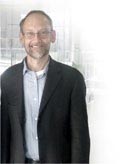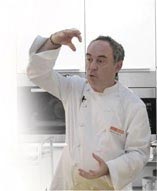Molecular Gastronomy 1: Science and Cooking
This is a summary of the first public lecture about molecular gastronomy held at Harvard in the fall of 2010. The video of the lecture is available on YouTube.
Science and Cooking: A Dialogue. Speakers: Harold McGee, Ferran Adria (elBulli), José Andrés (minibar by josé andrés, Jaleo, The Bazaar) with commentary/moderation from Professors David Weitz and Michael Brenner (Harvard).
The lecture starts with a brief introduction by Harvard Professors and the Dean thanking the sponsors and explaining the origin of the course. After the introduction, the actual molecular gastronomy lecture starts with Harold McGee, author who writes about chemistry, technique and history of food and cooking.
Harold McGee
 Harold McGee focuses on the history of the science of cooking and shows how the concept of using science in the kitchen and to innovate is not new and goes way back to the 18th century. Even the term “nouvelle cuisine” was used back then. He then goes through some inventions like the oven and statements like “searing meat seals in the juices” from the beginning of the 18th and 19th century.
Harold McGee focuses on the history of the science of cooking and shows how the concept of using science in the kitchen and to innovate is not new and goes way back to the 18th century. Even the term “nouvelle cuisine” was used back then. He then goes through some inventions like the oven and statements like “searing meat seals in the juices” from the beginning of the 18th and 19th century.
In the 20th century however, there was a hiatus in the interest in the science of cooking until Nicholas Kurti, a physicist, gave a lecture about the science of cooking and was broadcast by the BBC in London. Kurti said “I think it is a sad reflection on our society that while we can and do measure the temperature in the atmosphere of Venus, we do not know what goes on inside our soufflés.” Most food scientists at that time were more interested in food safety and manufacturing.
Harold McGee then started making experiments on his own and he talks about some of them. Julia Child’s use to say that when you whip egg whites to make a meringue or a soufflé you should use a copper bowl because that gives you a better foam. He did the experiment and he found that it actually makes a huge difference to use a copper bowl.
He then explains how the Molecular Gastronomy term was born in 1992 during a series of workshops held in Italy about the physics and chemistry of cooking (see Molecular Gastronomy History). He does clarify that what happens at most restaurants like El Bulli and others had nothing to do with the kind of things that were discussed during those meetings but that the term Molecular Gastronomy has been used to describe these restaurants and chefs.
He then shows a statement from Francois Marin ~1750 that he thinks it accurately represents French cuisine until now. “Modern cooking is a form of chemistry. The science of the cook today is to break down and distill meats into their quintessence, to take their juices and mix them together, in such a way that none dominates and all can be tasted, so that their different flavors result in a harmony of all tastes joined together.”
He then proceeds to compare Michel Bras, creator of the Molten Chocolate Cake, and Ferran Adria. Michel Bras used the local things that were in season to create a dish. He created a famous dish called Gargouillou, which is a miscellany of herbs, vegetables, sprouts that he would gather over the course of the morning and he would prepare over the course of the day. Each ingredient was prepared separately to perfection. This dish quickly became an icon and it is usually used as a reference point for the new way of looking at cooking.
Ferran then took this basic idea and tried to really be creative with it. It took him a couple of years but he came up with a dish of a mixture of fruit, vegetables and a herb but none of the components in the dish looked like where they came from.
Harold McGee says “Michel Bras takes the bounty of nature, celebrates the bounty of nature, presents it to you as the bounty of nature in a beautiful way while Ferran starts with the bounty of nature and then moves on to the bounty of the imagination to do things that have never been done before and that can give us something more from the experience of cooking and eating that we’ve gotten in the past.”
Synthesis of elBulli cuisine
1- Cooking is a language through which all the following properties may be expressed: harmony, creativity, happiness, beauty, poetry, complexity, magic, humor, provocation and culture.
2- As has occurred in most fields of human evolution down the ages, new technologies are a resource of the progress of cooking.
Harold McGee’s speech about the history of science in the kitchen and molecular gastronomy is then followed by Ferran Adria who speaks in Spanish and is translated by Jose Andres.
Ferran Adria
 Ferran Adria talks about the close of el bulli as a restaurant and the new phase as a private foundation with a center of creativity. He plans to share on the internet everything done at the foundation on a daily basis so other chefs and people interested in cooking can benefit from this research.
Ferran Adria talks about the close of el bulli as a restaurant and the new phase as a private foundation with a center of creativity. He plans to share on the internet everything done at the foundation on a daily basis so other chefs and people interested in cooking can benefit from this research.
“Avant-garde cuisine is like creating a new language and you need a new alphabet. It has taken a long time to make people understand this new language. For this new language in cooking we need new techniques and products.”
At El Bulli he has been working very hard to create concepts that will open new ways of doing things. Concepts are the most difficult to create, he says. It is very easy to come up with variations of existing concepts.
He then goes over some of his creations in the past like hot gelatin with agar agar in 1998, the story of basic spherification and reverse spherification (see El Bulli - Spherification History) and olive oil caviar.
Olive oil caviar is made using an encapsulation machine which surrounds olive oil drops with a thin layer of water with sodium alginate and the drops then go into a calcium bath (basic spherification). The oil does not gelatinize and it is not different from the original olive oil but with this method he is able to create a thin capsule of gelatin to form the olive oil caviar. He announced that this olive oil caviar will be commercially available soon in Europe.
Ferran Adria then talks about the controversy on what’s natural and not natural. He says, if you ask people if they would eat red snapper with sodium chloride, the answer would be no! But red snapper with salt, yes! And there is no difference. He believes there is a continued manipulation and that the lack of education is the problem. With good education, each person can decide on their own.
The white sugar for example, has a huge chemical and physical processing. Same as wine. What is the similarity between grape and wine? Nothing is the same. What about olive and olive oil? No resemblance at all. It is very important that this education gets into schools. Without this education, all the health reform that is happening in the US or other countries has no meaning. It will be an effort that will go to waste. It is a very important economic decision. Obesity costs million of dollars. With the right education the cost would be 10%. That’s why cooks are very important for this. When they speak about cooking people listen to cooks.
He then shows another variation of the spherification process which actually results in a rectangular shape rather than a spherical shape. In this case he showed the process of creating “basil pesto ravioli”. He mixes olive oil, basil, salt, pine nuts, gluco, xanthan gum and gelatin. He then pours the liquid on a tray and refrigerates it until it converts into a gel thanks to the gelatin added. He then cuts the raviolis and immerses them in a water bath with the alginate to create a thin layer of gel through reverse spherification. He then steams them in water. “The idea was to make a ravioli that was the sauce.” Ferran says.
Spherification helps to create a language. This language can be spoken well or not. It is easier to find good spherification than a good pizza today. Like in everything else, there are good cooks and bad cooks. But this moves us forward. If there is no risk, there is no gain.”
It is important the variety and not the monopolization of techniques. Biting a carrot or celery is also rewarding and fulfilling.




 (1 votes, average: 4.00)
(1 votes, average: 4.00)
